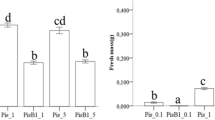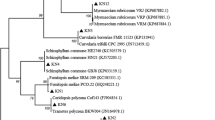Abstract
Fungal co-cultures appear to be advantageous for ligninolytic enzyme (LE) production compared to single fungal strains. The aims of this study were (1) to determine the type of fungal interactions in the co-cultures of two white-rot fungi (WRF, Pycnoporus sanguineus and Trametes maxima) and eight soil-borne micromycetes (SBM), (2) to determine the laccase and manganese peroxidase (MnP) activities and the hydrogen peroxide (H2O2) production in two compatible fungal and micromycetic co-cultures in submerged fermentation, and (3) to understand the effect of H2O2 on LE production by WRF through a dose-response bioassay. In the co-culture of SBM and Pycnoporus sanguineus, the main interaction was deadlock at a distance, whereas T. maxima showed competitive antagonism and replaced the SBM. In the agar plates, Purpureocillium lilacinum (27.8-fold increase) and Beauveria brongniartii (9.4-fold increase) enhanced the laccase and MnP activities of P. sanguineus, and Metarhizium anisopliae (Ma129) (0.83-fold increase) and Trichoderma sp. SP6 (22.6-fold increase) similarly enhanced these activities in T. maxima. In submerged fermentation, P. lilacinum also increased the laccase and MnP activities of P. sanguineus. The laccase activity of T. maxima only increased in the co-culture with B. brongniartii. The co-cultures achieved higher H2O2 production compared to the WRF monoculture, which played a vital role in the increase of LE. The dose-response assays revealed that low concentrations of H2O2 (2.94 and 14.69 mM) enhance the laccase and MnP activities in WRF.





Similar content being viewed by others
Explore related subjects
Discover the latest articles, news and stories from top researchers in related subjects.References
Arfi Y, Levasseur A, Record E (2013) Differential gene expression in Pycnoporus coccineus during interspecific mycelial interactions with different competitors. Appl Environ Microbiol 79:6626–6636. https://doi.org/10.1128/AEM.02316-13
Badalyan SM, Innocenti G, Garibyan NG (2002) Antagonistic activity of xylotrophic mushrooms against pathogenic fungi of cereals in dual culture. Phytopathol Mediterr 41:200–225. https://doi.org/10.14601/Phytophatol_Mediterr-1668
Badalyan SM, Innocenti G, Garibyan NG (2004) Interaction between xylotrophic mushrooms and mycoparasitic fungi in dual culture experiments. Phytopathol Mediterr 43:44–48. https://doi.org/10.14601/Phytopathol_Mediterr-1733
Bader J, Mast-Gerlach E, Popovic MK, Bajpai R, Stah U (2010) Relevance of microbial co-culture fermentation in biotechnology. J Appl Microbiol 109:371–387. https://doi.org/10.1111/j.1365-2672.2009.04659.x
Baldrian P (2004) Increase of laccase activity during interspecific interactions of white-rot fungi. FEMS Microbiol Ecol 50:245–253. https://doi.org/10.1016/j.femsec.2004.07.005
Barrios-Estrada C, Rostro-Alanis MJ, Muñoz-Gutiérrez BD, Iqbal HMN, Kannan S, Parra-Saldívar R (2018) Emergent contaminants: endocrine disruptors and their laccase-assisted degradation – a review. Sci Total Environ 612:1516–1531. https://doi.org/10.1016/j.scitotenv.2017.09.013
Baweja M, Nain L, Kawarabayasi Y, Shukla P (2016) Current technological improvements in enzymes toward their biotechnological applications. Front Microbiol 7:965. https://doi.org/10.3389/fmicb.2016.00965
Bermek H, Li K, Eriksson K-E (2002) Studies on inactivation and stabilization of manganese peroxidase from Trametes versicolor. In: Viikari L, Lantto R (eds) Biotechnology in the pulp and paper industry, 8th ICBPPI meeting, Progress Biotechnol. Elsevier Science, Amsterdam, pp 141–149. https://doi.org/10.1016/S0921-0423(02)80016-8
Bertrand S, Bohni N, Schnee S, Schumpp O, Gindro K, Jean-Luc W (2014a) Metabolite induction via microorganism co-culture: a potential way to enhanced chemical diversity for drug discovery. Biotechnol Adv 32:1180–1204. https://doi.org/10.1016/j.biotechadv.2014.03.001
Bertrand S, Schumpp O, Bohni N, Monod M, Gindro K, Jean-Luc W (2014b) De novo production of metabolites by fungal co-cultures of Trichophyton rubrum and Bionectria ochroleuca. J Nat Prod 76:1157–1165. https://doi.org/10.1021/np400258f
Boddy L (2000) Interspecific combative interactions between wood-decaying basidiomycetes. FEMS Microbiol Ecol 31:185–194. https://doi.org/10.1111/j.1574-6941.2000.tb00683.x
Branden R, Malmstrom B, Vanngard T (1971) The interaction of fungal laccase with hydrogen peroxide and the removal of fluoride from the inhibited enzyme. Eur J Biochem 18:238–241. https://doi.org/10.1111/j.1432-1033.1971.tb01236.x
Chan-Cupul W, Heredia-Abarca G, Rodríguez-Vázquez R (2016) Atrazine degradation by fungal co-culture enzyme extracts under different soil conditions. J Environ Sci Health B 51:298–308. https://doi.org/10.1080/03601234.2015.1128742
Chaparro DF, Rosas DC, Varela A (2009) Aislamiento y evaluación de la actividad enzimática de hongos descomponedores de madera (Quindío, Colombia). Rev Iberoam Micol 26:238–243. https://doi.org/10.1016/j.riam.2009.03.005
Das A, Sing J, Yogalakshmi KN (2017) Laccase immobilized magnetic iron nanoparticles: fabrication and its performance evaluation in chlorpyrifos degradation. Int Biodeter Biodegrad 117:183–189. https://doi.org/10.1016/j.ibiod.2017.01.007
Díaz-Rodríguez R, Heredia G, Siles JA, Jurado M, Nazareno-Saparrat MC, García-Romera I, Sampedro I (2018) Enhancing laccase production by white-rot fungus Funalia floccosa LPSC232 in co-culture with Penicillium commune GHAIE86. Folia Microbiol. https://doi.org/10.1007/s12223-018-0635-y
Divya L, Sadasivan C (2016) Trichoderma viride laccase plays a crucial role in defense mechanism against antagonistic organism. Front Microbiol 7:1–5. https://doi.org/10.3389/fmicb.2016.00741
Dwivedi P, Vivekanand V, Pareek N, Sharma A, Singh RP (2011) Co-cultivation of mutant Penicillium oxalicum SAUE-3.510 and Pleurotus ostreatus for simultaneous biosynthesis of xylanase and laccase under solid-state fermentation. New Biotechnol 8:616–626. https://doi.org/10.1016/j.nbt.2011.05.006
Eugenio-Eugenio M, Carbajo JM, Martín JA, González AE (2009) Laccase production by Pycnoporus sanguineus under different culture conditions. J Basic Microbiol 49:433–440. https://doi.org/10.1002/jobm.200800347
Flores C, Casasanero CR, Trejo-Hernández MR, Galindo E, Serrano-Carreón L (2010) Production of laccase by Pleurotus ostreatus in submerged fermentation in co-cultures with Trichoderma viride. J Appl Microbiol 108:810–8147. https://doi.org/10.1111/j.1365-2672.2009.04493.x
Glenn KJ, Gold MH (1985) Purification and characterization of an extracellular2+-dependent peroxidase from the lignin-degrading basidiomycete, Phanerochaete chrysosporium. Arch Biochem Biophys 242:329–341. https://doi.org/10.1016/0003-9861(85)90217-6
Gönen C (2018) Enhancing bioconversion of duckweed by acid and hydrogen peroxide pretreatment method to improve biofuel productivity. Sugar Tech 20:474–481. https://doi.org/10.1007/s12355-017-0558-y
Heredia AG, Arias MR (2008) Saprobes and endomycorrhizal fungi in soils. In: Manson RH, Hernández VO, Gallina S, Mehltreter K (eds) Coffee agroecosystems of Veracruz: biodiversity, conservation and management. Institute of Ecology A. C. (INECOL A. C.) and National Institute of Ecology (INE-SEMARNAT), Veracruz, pp 193–213
Hiscox J, Baldrian P, Rogers HJ, Boddy L (2010) Changes in oxidative enzyme activity during interespecific mycelial interactions involving the white-rot fungus Trametes versicolor. Fungal Genet Biol 47:562–571. https://doi.org/10.1016/j.fgb.2010.03.007
Klassen NV, Marchington D, Mcgowan HCE (1994) H2O2 determination by the I3− method and by KMnO4 titration. Anal Chem 66:2921–2925. https://doi.org/10.1016/j.fgb.2010.03.007
Koroleva OV, Gavrilova VP, Stepanova EV, Lebedeva AI, Sverdlova NI, Landesman EO, Yavmetdinov IS, Yaropolov AI (2002) Production of lignin modifying enzymes by co-cultivated white-rot fungi Cerrena maxima and Coriolus hirsutus and characterization of laccase from Cerrena maxima. Enzym Microb Technol 30:573–580. https://doi.org/10.1016/S0141-0229(02)00021-2
Kuhar F, Castiglia V, Levin L (2015) Enhancement of laccase production and malachite green decolorization by co-culturing Ganoderma lucidum and Trametes versicolor in solid-state fermentation. Inter Biodeter Biodegrad 104:238–243. https://doi.org/10.1016/j.ibiod.2015.06.017
Kumar V, Baweja M, Liu H, Shukla P (2017) Microbial enzyme engineering: applications and perspectives. In: Shukla P (ed) Recent advances in applied microbiology. Springer Nature, Switzerland, pp 259–273. https://doi.org/10.1007/978-981-10-5275-0_13
Kumar V, Kumar-Dang A, Shukla P (2018) Engineering thermostable microbial xylanase toward its industrial applications. Mol Biotechnol 60:226–235. https://doi.org/10.1007/s12033-018-0059-6
Kumari S, Naraian R (2016) Decolorization of synthetic brilliant green carpet industry dye through fungal co-culture technology. J Environ Manag 180:172–179. https://doi.org/10.1016/j.jenvman.2016.04.060
Li D, Alic M, Brown JA, Gold MH (1995) Regulation of manganese peroxidase gene transcription by hydrogen peroxide, chemical stress, and molecular oxygen. Appl Environ Microbiol 61:341–345
Li X, Qiu-Man X, Jing-Sheng C, Ying-Jin Y (2016) Improving the bioremoval of sulfamethoxazole and alleviating cytotoxicity of its biotransformation by laccase producing system under coculture of Pycnoporus sanguineus and Alcaligenes faecalis. Bioresour Technol 220:333–340. https://doi.org/10.1016/j.biortech.2016.08.088
Mata G, Murrieta Hernández DM, Iglesias ALG (2005) Changes in lignocellulolytic enzyme activities in six Pleurotus spp. strains cultivated on coffee pulp in confrontation with Trichoderma spp. World J Microbiol Biotechnol 21:143–150. https://doi.org/10.1007/s11274-004-3041-3
Pan K, Zhao N, Yin Q, Zhang T, Xu X, Fang W, Hong Y, Fang Z, Xiao Y (2014) Induction of a laccase Lcc9 from Coprinopsis cinerea by fungal coculture and its application on indigo dye decolorization. Bioresour Technol 162:45–52. https://doi.org/10.1016/j.biortech.2014.03.116
Rastogi M, Shrivastava (2017) Recent advances in second generation bioethanol production: an insight to pretreatment, saccharification and fermentation. Renew Sust Energ Rev 80:330–340. https://doi.org/10.1016/j.rser.2017.05.225
Rateb M, Hallyburton I, Houssen W, Bull AT, Goodfellow M, Santhanam R, Jaspars M, Ebel R (2014) Induction of diverse secondary metabolites in Aspergillus fumigatus by microbial co-culture. RSC Adv 3:14444–14450. https://doi.org/10.1039/C3RA42378F
Rodríguez-Couto S (2018) Solid state fermentation for laccases production and their applications. In: Pandey A, Larroche C, Socol CR (eds) Current developments in biotechnology and bioengineering: current advances in solid-state fermentation. Elsevier Sciences, Amsterdam, pp 211–234. https://doi.org/10.1016/C2016-0-02261-1
Saleem R, Khurshid M, Ahmed S (2018) Laccase, manganese peroxidase and xylanase used for the bio-bleaching of paper pulp: an environmental friendly approach. Protein Pept Lett 25:180–186. https://doi.org/10.2174/0929866525666180122100133
Savoie JM, Mata G (2003) Trichoderma harzianum metabolites pre-adapt mushrooms to Trichoderma aggressivum antagonism. Mycologia 95:191–199 https://doi.org/10.2307/3762030
Sen SK, Raut S, Bandyopadhyay P, Raut S (2016) Fungal decolouration and degradation of azp dyes: a review. Fungal Biol Rev 30:112–113. https://doi.org/10.1016/j.fbr.2016.06.003
Sivakumar R, Rajedran R, Balakumar C, Tamilvendan M (2010) Isolation, screening and optimization of production medium for thermostable laccase production from Ganoderma sp. Int J Eng Sci Technol 2:7133–7141
Song Z, Vail A, Sadowsky MJ, Schilling JS (2011) Competition between two wood-degrading fungi with distinct influences on residues. FEMS Microbiol Ecol 79:109–117. https://doi.org/10.1111/j.1574-6941.2011.01201.x
Sunil SM, Renuka PS, Pruthvi K, Swetha M, Malini S, Veena SM (2011) Isolation, purification, and characterization of fugal laccase from Pleurotus sp. Enzyme Res. https://doi.org/10.4061/2011/248735
Urzúa U, Kersten PJ, Vicuña R (1998) Manganese peroxidase-dependent oxidation of glyoxylic and oxalic acids synthesized by Ceriporiopsis subvermispora produce extracellular hydrogen peroxide. Appl Environ Microbiol 64:68–73
Van Heerden A, Reoux NJ, Swart J, Gardner-Lubbe S, Botha A (2008) Assessment of wood degradation by Pycnoporus sanguineus when co-cultured with selected fungi. World J Microb Biotechnol 24:2489–2497. https://doi.org/10.1007/s11274-008-9773-8
Van Heerden A, Roux NJ, Swart J, Rypstra T, Gardner-Lubbe S, Botha A (2011) Chemical alterations induced by Pycnoporus sanguineus/Aspergillus flavipes co-cultures in wood from different tree species. Wood Sci Technol 45:237–248. https://doi.org/10.1007/s00226-010-0318-6
Velázquez-Cedeño MA, Farnet AM, Ferre E, Savoie JM (2004) Variations of lignocellulosic activities in dual cultures of Pleurotus ostreatus and Trichoderma longibrachiatum on unsterilized wheat straw. Mycologia 96:712–719. https://doi.org/10.1080/15572536.2005.11832919
Vikineswary S, Noorlidah A, Renuvathani M, Sekaran M, Pandey A, Jones EBG (2006) Productivity of laccase in solid substrate fermentation of selected agro-residues by Pycnoporus sanguineus. Bioresour Technol 97:171–177. https://doi.org/10.1016/j.biortech.2005.02.015
Xiao Y, Chen Q, Hang J, Shi YY, Xiao YZ, Wu J, Hong YZ, Wang YP (2004) Selective induction, purification and characterization of a laccase isozyme from the basidiomycete Trametes sp. AH28-2. Mycologia 96:26–35 https://doi.org/10.2307/3761984
Yanto DH, Tachibana S (2014) Potential of fungal co-culturing for accelerated biodegradation of petroleum hydrocarbons in soil. J Hazard Mater 15:454–463. https://doi.org/10.1016/j.jhazmat.2014.06.039
Yanto DHY, Hidayat A, Tachibana S (2017) Periodical biostimulation with nutrients addition and bioaugmentation using mixed fungal cultures to maintain enzymatic oxidation during extended bioremediation of oil soil microcosm. Int Biodeter Biodegrad 116:112–123. https://doi.org/10.1016/j.ibiod.2016.10.023
Zhang H, Hong YZ, Xiao YZ, Yuan J, Tu XM, Zhang XQ (2006) Efficient production of laccases by Trametes sp. AH28-2 in cocultivation with a Trichoderma strain. Appl Microbiol Biotechnol 73:89–94. https://doi.org/10.1007/s00253-006-0430-6
Zhang H, Zhang J, Zhang X, Geng A (2018) Purification and characterization of a novel manganese peroxidase from white-rot fungi Cerrena unicolor BBP6 and its application in dye decolorization and denim bleaching. Process Biochem 66:22–229. https://doi.org/10.1016/j.procbio.2017.12.011
Zhong Z, Li N, Liu L, He B, Igarashi Y, Luo F (2018) Label-free differentially proteomic analysis of interspecific interaction between white-rot fungi highlights oxidative stress response and high metabolic activity. Fungal Biol 122:774–784. https://doi.org/10.1016/j.funbio.2018.04.005
Zúñiga-Silva JR, Chan-Cupul W, Kuschk P, Loera O, Aguilar-López R, Rodríguez-Vázquez R (2016) Effect of Cd2+ on phosphate solubilizing abilities and hydrogen peroxide production of soil-borne micromycetes isolated from Phragmites australis-rhizosphere. Ecotoxicology 25:367–379. https://doi.org/10.1007/s10646-015-1595-5
Funding
The authors are grateful for the funding of the project “Mechanism of increasing ligninolytic enzyme activities of fungal co-cultures between white rot fungi and soil borne micromycetes” by the Institute Mexico-United States of the California University (UC-MEXUS-CONACyT).
Author information
Authors and Affiliations
Corresponding author
Ethics declarations
Conflict of interest
The authors declare that they have no conflict of interest.
Additional information
Publisher’s Note
Springer Nature remains neutral with regard to jurisdictional claims in published maps and institutional affiliations.
Rights and permissions
About this article
Cite this article
Wiberth, CC., Casandra, AZ.C., Zhiliang, F. et al. Oxidative enzymes activity and hydrogen peroxide production in white-rot fungi and soil-borne micromycetes co-cultures. Ann Microbiol 69, 171–181 (2019). https://doi.org/10.1007/s13213-018-1413-4
Received:
Accepted:
Published:
Issue Date:
DOI: https://doi.org/10.1007/s13213-018-1413-4




